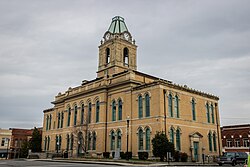Robertson County, Tennessee | |
|---|---|
 Robertson County Courthouse in Springfield | |
 Location within the U.S. state of Tennessee | |
 Tennessee's location within the U.S. | |
| Coordinates: 36°32′N86°52′W / 36.53°N 86.87°W | |
| Country | |
| State | |
| Founded | April 9, 1796 |
| Named after | James Robertson [1] |
| Seat | Springfield |
| Largest city | Springfield |
| Government | |
| • Mayor | Billy Vogle (I) |
| Area | |
• Total | 476 sq mi (1,230 km2) |
| • Land | 476 sq mi (1,230 km2) |
| • Water | 0.2 sq mi (0.52 km2) 0.04% |
| Population (2020) | |
• Total | 72,803 |
• Estimate (2025) | 79,532 |
| • Density | 153/sq mi (59.1/km2) |
| Time zone | UTC−6 (Central) |
| • Summer (DST) | UTC−5 (CDT) |
| Congressional district | 7th |
| Website | robertsoncountytn |
Robertson County is a county located on the central northern border of Tennessee in the United States. As of the 2020 United States census, the population was 72,803. Its seat of government is Springfield. [2] The county was named for James Robertson, an explorer, founder of Nashville, and a state senator, who was often called the "Father of Middle Tennessee." Robertson County is a component of the Nashville-Davidson – Murfreesboro – Franklin, TN Metropolitan Statistical Area.


